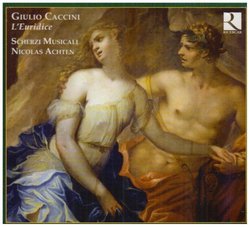Opera in its Marvelous Infancy
Theodore Deacon | Seattle, WA United States | 08/28/2009
(5 out of 5 stars)
"Finally we have on CD an excellent recording of Caccini's masterwork to set beside the fine sets of his colleague Peri's EURIDICE (to which Caccini contributed as well). Both use the same text by Ottavio Rinuccini, but the melodic and vocal writing are startlingly different in equally satisfying ways. I love them both, Peri for the lilting contours of his monody and Caccini for the immediacy of his dramatic instincts. I prefer Caccini's version by a small margin though any true lover of early opera would need both versions in their collection. This set is handsomely sung and sensitively accompanied by a sharp continuo ensemble. The recorded sound is warm and detailed. This is an exquisite listening experience."
The Other Version of the First Opera
Rev. Ben Cox | Orlando, Florida | 02/01/2010
(5 out of 5 stars)
"When Peri and Caccini collaborated together in 1601 to produce a work called L'Euridice, the work presented was Peri's with some spots by Caccini. Caccini, however produced his own complete work and submitted it for publication earlier than Peri. Both works were outgrowths of long discussions by the Florentine Camerata as to how the Greeks performed music in their plays, and as my readers might know, the Italian Renaissance was a result of the study of Greek and Roman manuscripts and the attempts to purify the excesses of composers. Both Peri and Caccini sought the same ideals: the sung text should be completely intelligible, because the rhythmic treatment of the text resembled speech as much as possible. They aimed for rhetorical expression of emotions, but used musical methods to obtain this. Peri would occasionally use surprising harmonies and dissonances, and avoided melodic lines that would take attention away from the text. Caccini's musical language is more vocal, with many melodic passages integrated into the recitative, and by using simple pure harmonies. Any use of more chromatic keys such as C or F minor are used as expressions of sorrowful emotion.
Having studied 17th Century Italian Art and music in my Master's program, I was very familiar with the Peri version, and when I spotted the Caccini version on Amazon, I jumped at the opportunity to hear the "other side of the coin" as it were. Remember that both versions of this "opera" were written to be performed in rooms of wealthy people for an event such as a royal marriage, not on a large stage in a large house. The closest we could get to it today would be an intimate chamber opera. They were not even called operas yet.
This recording is done by a young ensemble and is, to my ears an ideal choice for their first recording. Younger voices seem to be the most suited to convey freshness, naivety and innocence. The recording is beautifully done and very clear. The instrumental forces for Renaissance opera are always interesting because the score usually give us the vocal lines and a figured bass and very little else, so the fleshing out of the orchestra (or ensemble) becomes a very creative, reconstructive process. This recording uses triple harp, basse de viole,lirone, lutes, theorbos (beautiful bass lutes), guitars,clavecin and organ.
All in all, this is a beautiful recording of a rare piece of work and is quite affordable, therefore enabling the listener to have a wonderful listening and learning experience."


 Track Listings (22) - Disc #1
Track Listings (22) - Disc #1